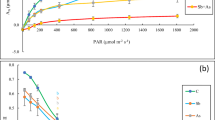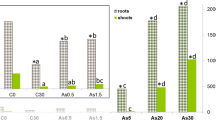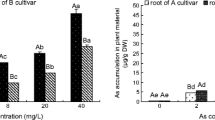Abstract
Variations of phytoaccumulation and tolerance in different growth stages of plant are important factors for effective removal of pollutants in phytoremediation. The present work investigated arsenic (As) accumulation, As-tolerance and the physiological tolerance mechanisms of Typha angustifolia under different As-level during the seedling, fast-growing and breeding stages. The results showed that As mainly distributed in the underground part and total As accumulation increased with growth stages. Maximum growth rates under lower As occurred in seedling stage, whereas occurred in breeding stage under higher As. T. angustifolia exhibited the highest tolerance ability under 150 mg kg−1 As and tolerance index (TI) varied from seedling to breeding stages. During seedling stage, TI was affected by plant height (Hshoot) and net photosynthesis, which control biomass production. During fast-growing stage, Hshoot and root glutathione (GSH) co-regulated plant As-tolerance. During breeding stage, physiological metabolic processes, especially GSH-mediated processes, played a critical role in improving plant As-tolerance.




Similar content being viewed by others
References
Ali MB, Vajpayee P, Tripathi RD et al (2003) Phytoremediation of lead, nickel, and copper by Salix acmophylla Boiss: role of antioxidant enzymes and antioxidant substances. Bull Environ Contam Toxicol 70:462–469
Anjum NA, Umar S, Ahmad A et al (2007) Sulphur protects mustard (Brassica campestris L.) from cadmium toxicity by improving leaf ascorbate and glutathione. Plant Growth Regul 54:271–279
Anjum NA, Ahmad I, Válega M et al (2013) Phenological development stages variation versus mercury tolerance, accumulation, and allocation in salt marsh macrophyte Striglochin maritima and Scirpus maritimus prevalent in Ria de Aveiro coastal lagoon (Portugal). Environ Sci Pollut Res 20:3910–3922
Baryla A, Laborde C, Montillet JL et al (2000) Evaluation of lipid peroxidation as a toxicity bioassay for plants exposed to copper. Environ Pollut 109:131–135
Blanco A, Salazar MJ, Vergara CC et al (2017) Accumulation of lead and associated metals (Cu and Zn) at different growth stages of soybean crops in lead-contaminated soils: food security and crop quality implications. Environ Earth Sci 76:182
Bonanno G (2011) Trace element accumulation and distribution in the organs of Phragmites australis (common reed) and biomonitoring applications. Ecotoxicol Environ Safe 74:1057–1064
Bonanno G, Cirelli GL (2017) Comparative analysis of element concentrations and translocation in three wetland congener plants Typha domingensis, Typha latifolia and Typha angustifolia. Ecotoxicol Environ Safe 143:92–101
Bonanno G, Vymazal J, Cirelli GL (2018) Translocation, accumulation and bioindication of trace elements in wetland plants. Sci Total Environ 631–632:252–261
Branković S, Glišić R, Topuzović M, Marin M (2015) Uptake of seven metals by two macrophytes species: potential for phytoaccumulation and phytoremediation. Chem Ecol 31:583–593
Chakraborti D, Rahman MM, Mukherjee A et al (2015) Groundwater arsenic contamination in Bangladesh-21 years of research. J Trace Elem Med Biol 31:237–248
Chandra R, Yadav S (2010) Potential of Typha angustifolia for phytoremediation of heavy metals from aqueous solution of phenol and melanoidin. Ecol Eng 36:1277–1284
Chen J, Wang SX, Zhang S et al (2015) Arsenic pollution and its treatment in Yangzonghai lake in China: in situ remediation. Ecotoxicol Environ Safe 122:178–185
Ebrahem ME, Sulaiman AA, Tarek MG et al (2019) Prediction models for evaluating the heavy metal uptake by spinach (Spinacia oleracea L.) from soil amended with sewage sludge. Int J Phytoremediat. https://doi.org/10.1080/15226514.2018.1488815
Farooq MA, Li L, Ali B et al (2015) Oxidative injury and antioxidant enzymes regulation in arsenic-exposed seedlings of four Brassica napus L. cultivars. Environ Sci Pollut Res 22:10699–10712
Gómez-Bernal JM, Ruiz-Huerta EA, Armienta Hernández MAA, Luna-Pabello VM (2017) Heavy metals and arsenic phytoavailability index in pioneer plants from a semipermanent natural wetland. Environ Prog Sustain 37:980–988
Greenland S, Maclure M, Schlesselman JJ et al (1991) Standardized regression coefficients: a further critique and review of some alternatives. Epidemiology 2:387–392
Hartley-Whitaker J, Ainsworth G, Meharg AA (2001) Copper‐and arsenate‐induced oxidative stress in Holcus lanatus L. clones with differential sensitivity. Plant Cell Environ 24:713–722
Jomjun N, Siripen T, Maliwan S et al (2010) Phytoremediation of arsenic in submerged soil by wetland plants. Int J Phytoremediat 13:35–46
Karunaratne S, Asaeda T, Yutani K (2004) Shoot regrowth and age-specific rhizome storage dynamics of phragmites australis subjected to summer harvesting. Ecol Eng 22:99–111
Krishna KY, Neha G, Amit K et al (2018) Mechanistic understanding and holistic approach of phytoremediation: a review on application and future prospects. Ecol Eng 120:274–298
Kumari A, Pandey N, Pandey-Rai S (2017) Protection of Artemisia annua roots and leaves against oxidative stress induced by arsenic. Biol Plant 61:367–377
Lessl JT, Luo J, Ma LQ (2014) Pteris vittata continuously removed arsenic from non-labile fraction in three contaminated-soils during 3.5 years of phytoextraction. J Hazard Mater 279:485–492
Li QY, Lei S, Du KB et al (2016) RNA-seq based transcriptomic analysis uncovers α-linolenic acid and jasmonic acid biosynthesis pathways respond to cold acclimation in Camellia japonica. Sci Rep 6:36463
Liang T, Ding H, Wang G et al (2015) Sulfur decreases cadmium translocation and enhances cadmium tolerance by promoting sulfur assimilation and glutathione metabolism in Brassica chinensis L. Ecotoxicol Environ Safe 124:129–137
Liu WJ, Wood BA, Raab A et al (2010) Complexation of arsenite with phytochelatins reduces arsenite efflux and translocation from roots to shoots in Arabidopsis. Plant Physiol 152:2211–2221
Liu RB, Yang CL, Li SY et al (2014) Arsenic mobility in the arsenic-contaminated Yangzonghai lake in China. Ecotoxicol Environ Safe 107:321–327
Liu X, Feng HY, Fu JW et al (2018) Phytate promoted arsenic uptake and growth in arsenic-hyperaccumulator Pteris vittata by upregulating phosphorus transporters. Environ Pollut 241:240–246
Logoteta B, Xu XY, Macnair MR et al (2009) Arsenite efflux is not enhanced in the arsenate-tolerant phenotype of Holcus lanatus. New Phytol 183:340–348
Ma LQ, Komar KM, Tu C et al (2001) A fern that hyperaccumulates arsenic: a hardy, versatile, fast-growing plant helps to remove arsenic from contaminated soils. Nature 409:579
Meharg AA, Hartley-Whitaker J (2002) Arsenic uptake and metabolism in arsenic resistant and non-resistant plant species. New Phytol 154:29–43
Milošković A, Branković S, Simić V et al (2013) The accumulation and distribution of metals in water, sediment, aquatic macrophytes and fishes of the Gruža Reservoir, Serbia. Environ Contam Toxicol 90:563–569
Niazi NK, Singh B, Shah P (2011) Arsenic speciation and phytoavailability in contaminated soils using a sequential extraction procedure and XANES spectroscopy. Environ Sci Technol 45:7135–7142
Nikalje GC, Penna S (2018) Coping with metal toxicity–cues from halophytes. Front Plant Sci 9:777–787
Pandey VC, Singh N, Singh RP, Singh DP (2014) Rhizoremediation potential of spontaneously grown Typha latifolia on fly ash basins: study from the field. Ecol Eng 71:722–727
Peralta-Videa JR, de la Rosa G, Gonzalez JH, Gardea-Torresdey JL (2004) Effects of the growth stage on the heavy metal tolerance of alfalfa plants. Adv Environ Res 8:679–685
Prasanna K, Saman S, Andrew M, Jochen B (2018) Arsenic accumulation in rice (Oryza sativa L.) is influenced by environment and genetic factors. Sci Total Environ 642:485–496
Requejo R, Tena M (2012) Influence of glutathione chemical effectors in the response of maize to arsenic exposure. J Plant Physiol 169:649–656
Rodríguez-Lado L, Sun GF, Berg M et al (2013) Groundwater arsenic contamination throughout China. Science 341:866–869
Rosales M, Coreño O, Nava JL (2018) Removal of hydrated silica, fluoride and arsenic from groundwater by electrocoagulation using a continuous reactor with a twelve-cell stack. Chemosphere 211:149–155
Smita K, Trivedi PK (2018) Glutathione S-transferases: role in combating abiotic stresses including arsenic detoxification in plants. Front Plant Sci 9:751–759
Sun YB, Zhou QX, Wang L, Liu WT (2009) The influence of different growth stages and dosage of EDTA on Cd uptake and accumulation in Cd-hyperaccumulator (Solanum nigrum L.). Bull Environ Contam Toxicol 82:348–353
Tuli R, Chakrabarty D, Trivedi PK, Tripathi RD (2010) Recent advances in arsenic accumulation and metabolism in rice. Mol Breed 26:307–323
US EPA (1996) Method 3050B: acid digestion of sediments, sludges, and soils, 2nd edn. Washington, DC
Vezza ME, Luna DF, Agostini E, Talano MA (2019) Glutathione, a key compound for as accumulation and tolerance in soybean plants treated with AsV and AsIII. Environ Exp Bot 162:272–282
Wan XM, Lei M, Chen TB (2016) Cost–benefit calculation of phytoremediation technology for heavy-metal-contaminated soil. Sci Total Environ 563–564:796–802
Wang HB, Xie F, Yao YZ et al (2012) The effects of arsenic and induced-phytoextraction methods on photosynthesis in Pteris species with different arsenic-accumulating abilities. Environ Exp Bot 75:298–306
Wang ZQ, Hou L, Liu YG, Wang Y, Ma LQ (2018) Metal contamination in a riparian wetland: distribution, fractionation and plant uptake. Chemosphere 200:587–593
Wenzel WW, Kirchbaumer N, Prohaska T et al (2001) Arsenic fractionation in soils using an improved sequential extraction procedure. Anal Chim Acta 436:309–323
Zeng P, Guo ZH, Xiao XY et al (2019) Phytoextraction potential of Pteris vittata L. co-planted with woody species for As, Cd, Pb and Zn in contaminated soil. Sci Total Environ 650:594–603
Zhao FJ, Mcgrath SP, Meharg AA (2010) Arsenic as a food chain contaminant: mechanisms of plant uptake and metabolism and mitigation strategies. Annu Rev Plant Biol 61:535–559
Zhou XJ, Sun CY, Zhu PF, Liu F (2018) Effects of antimony stress on photosynthesis and growth of Acorus calamus. Front Plant Sci 9:579
Acknowledgements
This work was supported by the National Natural Science Foundation of China (Grant Nos. 31670522, 41867066, 31660169), Yunnan Provincial Natural Science Foundation of China (Grant Nos. 2018FB044, 2018BC001, C6183014, 2019BC001), and the Key Laboratory of Soil Erosion and Controlling of Yunnan Provincial Education Department (Grant No. 51700202).
Author information
Authors and Affiliations
Corresponding author
Additional information
Publisher's Note
Springer Nature remains neutral with regard to jurisdictional claims in published maps and institutional affiliations.
Electronic supplementary material
Below is the link to the electronic supplementary material.
Rights and permissions
About this article
Cite this article
Yang, G., Zhong, H., Liu, X. et al. Arsenic Distribution, Accumulation and Tolerance Mechanisms of Typha angustifolia in Different Phenological Growth Stages. Bull Environ Contam Toxicol 104, 358–365 (2020). https://doi.org/10.1007/s00128-020-02796-y
Received:
Accepted:
Published:
Issue Date:
DOI: https://doi.org/10.1007/s00128-020-02796-y




